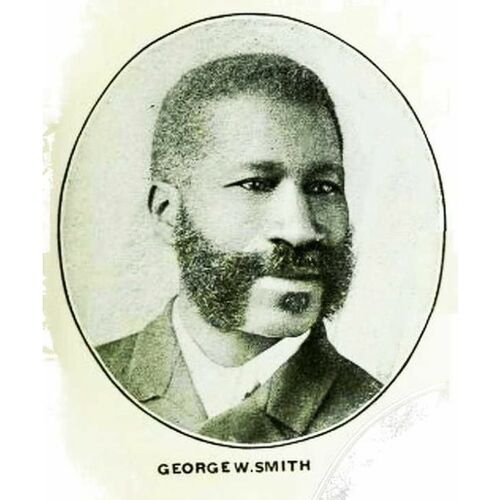
Source: Link
SMITH, GEORGE WASHINGTON, barber and news-vendor; b. 15 March 1845 in Charles Town (W. Va), son of Washington Smith and Sydney —; m. 5 July 1866 Eliza Jane Campbell in Toronto, and they had two daughters and three sons; d. there 24 Dec. 1921.
George Washington Smith immigrated to Canada in 1864 at age 18 or 19, and settled in Toronto. Two years later he and Eliza Jane Campbell, a young black woman from Bowmanville, were married by Baptist minister Thomas Ford Caldicott*. By this time, Smith had already established an entrepreneurial presence, having started out on King Street as a barber. By 1871 he had a shop in the Queen’s Hotel on Front Street, in addition to his Colossal Shaving Parlour at King and York streets. An advertisement in the city directory of 1874 promised patrons a “good refreshing bath” and “shampooing, shaving, and hairdressing done with neatness and civility.” By this juncture Smith had clearly come into his own; his business was doing so well that he had set up shop at yet another location, the American Hotel at Yonge and Front.
Smith’s success set a foundation from which he was able to prosper for some years. Between the mid 1870s and the turn of the century, the Evening Telegram would note at his death, he was “well known in downtown business circles.” His barber-shops, which appeared at various times on Queen Street and in Union Station, with periodic returns to King Street, were evidently frequented by many of the city’s business elite. According to the Toronto Daily Star, his economic presence simultaneously enabled him to become “prominent . . . in Toronto’s political circles.” Though generally a staunch Conservative, he supported Robert John Fleming, a populist, Liberal-leaning mayor who ran on anti-business platforms that advocated worker’s rights and temperance. His campaigns were also infused with undertones of racial and gender equality. Smith’s affiliation with the Royal Templars of Temperance as well as his black identity likely drew him to Fleming, even though this position was arguably antithetical to his interests as a businessman. Taking to the stump in support of Fleming on several occasions between 1891 and 1897, Smith earned a reputation as an entertaining and compelling orator. His other associations helped cement his standing: he was a member of the Orange lodge, the Ancient Order of Foresters, and the York Pioneers. Thus, through his various affiliations, he became known as a leader of Toronto’s “colored colony.”
Despite his success, Smith found himself compelled to give up barbering around 1909 or 1910, likely because he had lost his sight and perhaps because of advancing age. The death in 1907 of his wife, who owned the family home, may also have affected his state of affairs. Eliza left her property to him and four children but stipulated in her will that George was to take possession only after relinquishing all other claims to her estate. He managed to sustain himself as a newspaper dealer. The status he had enjoyed in earlier years can be gauged from the fact that his stand, at the northwest corner of Queen Street and Spadina Avenue, was, the Globe would recall, “the first permitted on the city corners.”
Smith met a tragic end. On a cold December night in 1921 he reportedly fell against a hot stove in his news-stand. He was taken to Toronto Western Hospital, where, after 24 hours, he died of “shock following burns,” an agonizing death for a blind man of 77 years. He was buried in Mount Pleasant Cemetery. The circumstances surrounding his passing made the city take note – the Globe, the Star, and the Telegram all ran brief chronicles of his life. Probate records indicate that his estate consisted of residential property, real estate, and Victory Bonds with a total value of $2,716.46, a figure that placed him in the ranks of the city’s tiny black bourgeoisie. A lifelong Baptist, he left $150 to the Beverley Street Baptist Church.
George Washington Smith’s life is intriguing. A relatively obscure figure in Canadian black history, he had nonetheless been known to contemporaries as a leader in Toronto’s black community and, later, as a stock figure of sorts at street corners. Further research is needed, however, to determine whether he was widely seen as a leader by members of the black community or whether the mantle was a result of his associations with the city’s white elite and the integrationist ethos that characterized much of his life. There is no doubt that, at his peak, Smith had managed to carve out a place for himself at a time when the majority of Toronto’s “colored colony” struggled in the face of racial slurs, Jim Crowism, and residential, social, and occupational discrimination.
AO, RG 22-305, nos.19521, 44223; RG 80-2-0-89, no.36343; RG 80-2-0-156, no.41673; RG 80-2-0-226, no.42952; RG 80-8-0-804, no.7475; RG 80-27-2, 67: 1. City of Toronto Arch., RG 5, F, (assessment rolls), sub-ser.1, 1834–1951. Evening Telegram (Toronto), 28 Dec. 1891, 27 Dec. 1921. Globe, 27 Dec. 1921. Toronto Daily Star, 27 Dec. 1921.— Directories, Ont., 1871; Toronto, 1867–1921.
Cite This Article
Barrington Walker, “SMITH, GEORGE WASHINGTON,” in Dictionary of Canadian Biography, vol. 15, University of Toronto/Université Laval, 2003–, accessed December 24, 2025, https://www.biographi.ca/en/bio/smith_george_washington_15E.html.
The citation above shows the format for footnotes and endnotes according to the Chicago manual of style (16th edition). Information to be used in other citation formats:
| Permalink: | https://www.biographi.ca/en/bio/smith_george_washington_15E.html |
| Author of Article: | Barrington Walker |
| Title of Article: | SMITH, GEORGE WASHINGTON |
| Publication Name: | Dictionary of Canadian Biography, vol. 15 |
| Publisher: | University of Toronto/Université Laval |
| Year of publication: | 2005 |
| Year of revision: | 2005 |
| Access Date: | December 24, 2025 |



